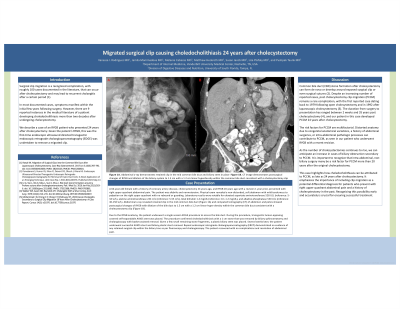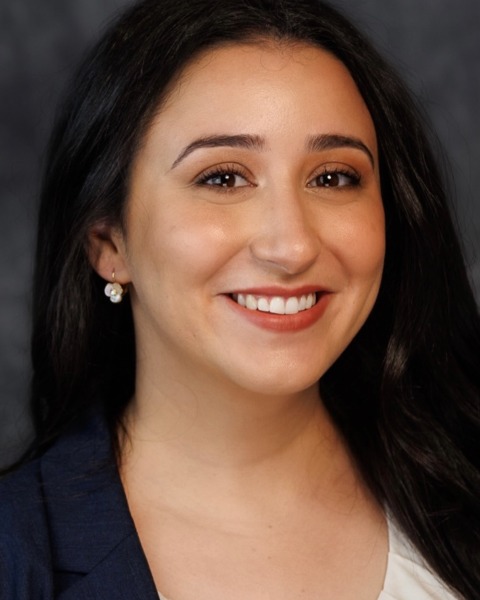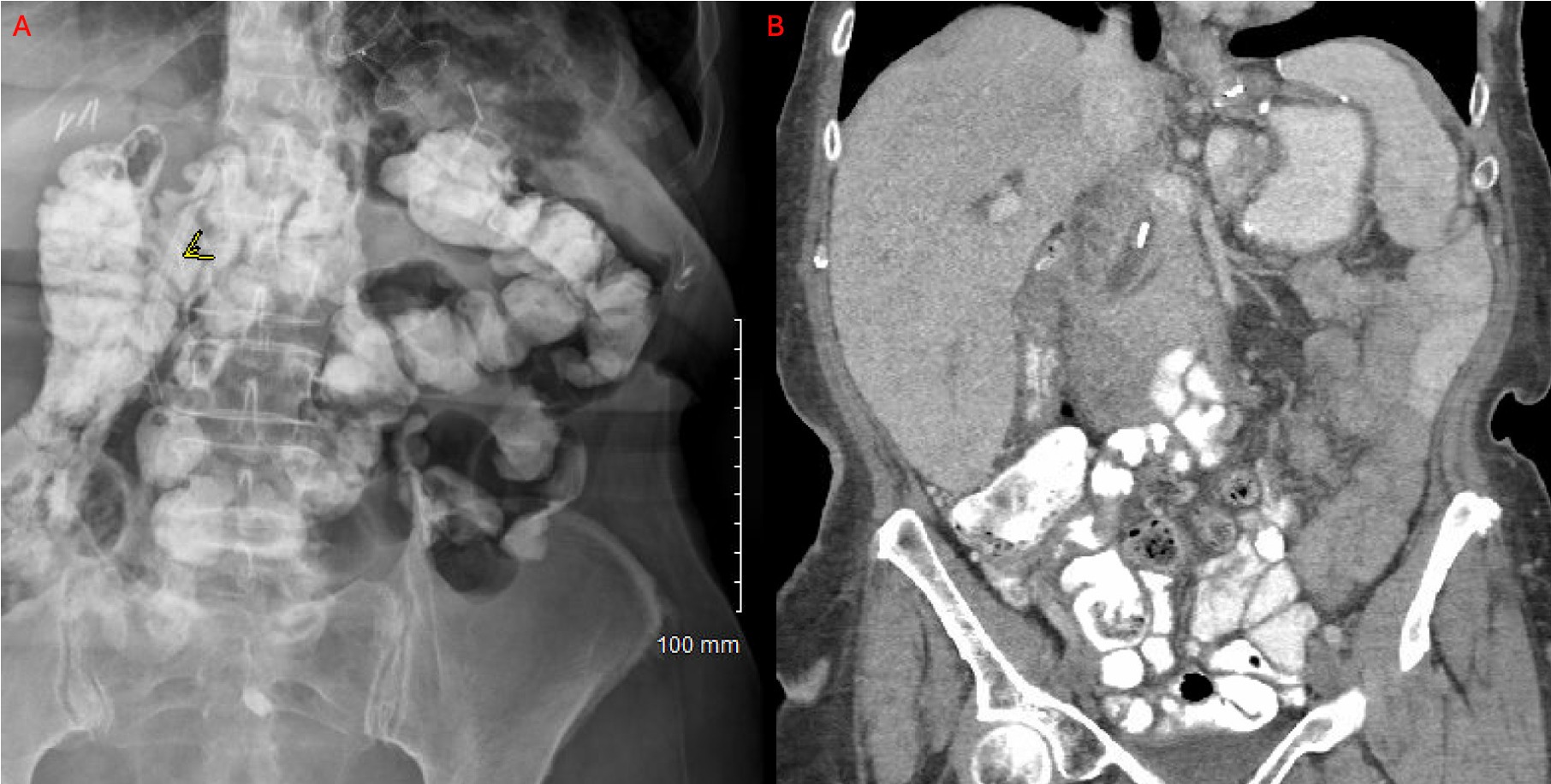Tuesday Poster Session
Category: Biliary/Pancreas
P3556 - Migrated Surgical Clip Causing Choledocholithiasis More Than 20 Years After Cholecystectomy
Tuesday, October 29, 2024
10:30 AM - 4:00 PM ET
Location: Exhibit Hall E

Has Audio

Vanessa I. Rodriguez, MD
Vanderbilt University Medical Center
Nashville, TN
Presenting Author(s)
Jamila Mammadova, MD1, Vanessa I. Rodriguez, MD1, Melanie Cabezas, MD2, Matthew Heckroth, MD2, Susan Jacob, MD2, Liza Plafsky, MD2, Pushpak Taunk, MD2
1Vanderbilt University Medical Center, Nashville, TN; 2University of South Florida, Tampa, FL
Introduction: Surgical clip migration is a recognized complication of laparoscopic cholecystectomy and may lead to recurrent cholangitis after a certain period. These migrated surgical clips can serve as a focal point for the formation of stones. In most documented cases, symptoms manifest within the initial few years following surgery. We report a case of surgical clip choledocholithiasis more than 20 years after cholecystectomy in a patient with a history of Roux-en-Y gastric bypass (RYGB).
Case Description/Methods: A 64-year-old female with a history of cholecystectomy 24 years ago and RYGB 20 years ago with revision in 2022 presented with abdominal pain. On presentation, the patient was afebrile, normotensive and physical exam revealed right upper quadrant tenderness. Laboratory results were notable for elevated aspartate aminotransferase 528 U/L (reference: 5-34 U/L), alanine aminotransferase 244 U/L (reference: 5-55 U/L), total bilirubin 1.4 mg/dL (reference: 0.1-1.2 mg/dL), and alkaline phosphatase 530 U/L (reference: 40-150 U/L). Abdominal x-ray (Figure 1A) and computed tomography (CT) revealed retained clip within the common bile duct consistent (Figure 1B).
The patient underwent endoscopic ultrasound directed transgastric ERCP (EDGE) to access the bile duct. During the procedure, transgastric lumen-apposing covered self-expandable AXIOS stent was placed. The procedure confirmed choledocholithiasis with 1 cm stone that was removed by biliary sphincterotomy, SpyGlass cholangioscopy, and basket assisted removal. Repeat ERCP demonstrated no evidence of any retained surgical clip within the biliary tree as per fluoroscopy and cholangioscopy. The patient recovered with no complications and resolution of abdominal pain.
Discussion: As the number of cholecystectomies continues to rise, we can anticipate an increase in cases of acute cholangitis secondary to post cholecystectomy clip migration (PCCM). It is important to recognize that PCCM can be precipitated by intra-abdominal non-biliary surgery even more than 20 years after the original cholecystectomy. This case highlights how acute cholangitis can be attributed to PCCM, triggered by a recent intra-abdominal surgery, even as late as 23 years after cholecystectomy. It is essential to include clip migration as a potential differential diagnosis for patients who present with acute cholangitis and a history of cholecystectomy in the past. Recognizing this possibility early and accurately is crucial for ensuring successful treatment.

Disclosures:
Jamila Mammadova, MD1, Vanessa I. Rodriguez, MD1, Melanie Cabezas, MD2, Matthew Heckroth, MD2, Susan Jacob, MD2, Liza Plafsky, MD2, Pushpak Taunk, MD2. P3556 - Migrated Surgical Clip Causing Choledocholithiasis More Than 20 Years After Cholecystectomy, ACG 2024 Annual Scientific Meeting Abstracts. Philadelphia, PA: American College of Gastroenterology.
1Vanderbilt University Medical Center, Nashville, TN; 2University of South Florida, Tampa, FL
Introduction: Surgical clip migration is a recognized complication of laparoscopic cholecystectomy and may lead to recurrent cholangitis after a certain period. These migrated surgical clips can serve as a focal point for the formation of stones. In most documented cases, symptoms manifest within the initial few years following surgery. We report a case of surgical clip choledocholithiasis more than 20 years after cholecystectomy in a patient with a history of Roux-en-Y gastric bypass (RYGB).
Case Description/Methods: A 64-year-old female with a history of cholecystectomy 24 years ago and RYGB 20 years ago with revision in 2022 presented with abdominal pain. On presentation, the patient was afebrile, normotensive and physical exam revealed right upper quadrant tenderness. Laboratory results were notable for elevated aspartate aminotransferase 528 U/L (reference: 5-34 U/L), alanine aminotransferase 244 U/L (reference: 5-55 U/L), total bilirubin 1.4 mg/dL (reference: 0.1-1.2 mg/dL), and alkaline phosphatase 530 U/L (reference: 40-150 U/L). Abdominal x-ray (Figure 1A) and computed tomography (CT) revealed retained clip within the common bile duct consistent (Figure 1B).
The patient underwent endoscopic ultrasound directed transgastric ERCP (EDGE) to access the bile duct. During the procedure, transgastric lumen-apposing covered self-expandable AXIOS stent was placed. The procedure confirmed choledocholithiasis with 1 cm stone that was removed by biliary sphincterotomy, SpyGlass cholangioscopy, and basket assisted removal. Repeat ERCP demonstrated no evidence of any retained surgical clip within the biliary tree as per fluoroscopy and cholangioscopy. The patient recovered with no complications and resolution of abdominal pain.
Discussion: As the number of cholecystectomies continues to rise, we can anticipate an increase in cases of acute cholangitis secondary to post cholecystectomy clip migration (PCCM). It is important to recognize that PCCM can be precipitated by intra-abdominal non-biliary surgery even more than 20 years after the original cholecystectomy. This case highlights how acute cholangitis can be attributed to PCCM, triggered by a recent intra-abdominal surgery, even as late as 23 years after cholecystectomy. It is essential to include clip migration as a potential differential diagnosis for patients who present with acute cholangitis and a history of cholecystectomy in the past. Recognizing this possibility early and accurately is crucial for ensuring successful treatment.

Figure: Figure 1: A: Abdominal x-ray demonstrates retained clip in the mid common bile duct and biliary stent in place. B: CT image demonstrates postsurgical changes of RYGB and dilation of the biliary system to 1.5 cm with a 1.2 cm linear hyperdensity within the common bile duct consistent with a cholecystectomy clip. CT, computed tomography; RYGB, Roux-en-Y gastric bypass.
Disclosures:
Jamila Mammadova indicated no relevant financial relationships.
Vanessa Rodriguez indicated no relevant financial relationships.
Melanie Cabezas indicated no relevant financial relationships.
Matthew Heckroth indicated no relevant financial relationships.
Susan Jacob indicated no relevant financial relationships.
Liza Plafsky indicated no relevant financial relationships.
Pushpak Taunk: Boston Scientific – Consultant. Neptune Medical – Consultant.
Jamila Mammadova, MD1, Vanessa I. Rodriguez, MD1, Melanie Cabezas, MD2, Matthew Heckroth, MD2, Susan Jacob, MD2, Liza Plafsky, MD2, Pushpak Taunk, MD2. P3556 - Migrated Surgical Clip Causing Choledocholithiasis More Than 20 Years After Cholecystectomy, ACG 2024 Annual Scientific Meeting Abstracts. Philadelphia, PA: American College of Gastroenterology.
